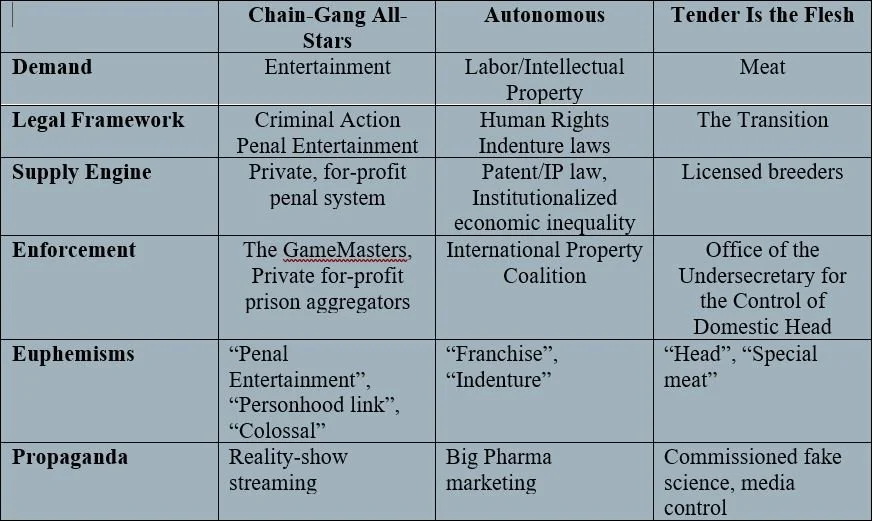How to Consume a Human
My last three reads, in order, were Nana Kwame Adjei-Brenyah’s Chain-Gang All-Stars, Annalee Newitz’s Autonomous, and Agustina Bazterrica’s Tender Is the Flesh. (It was a terrifying experience, I assure you.)
Beyond intense gore/body-horror, they share a common theme: humans owning other humans (or pieces thereof). Eventually, my head spun off and I had to get it out: here’s Part 1 of my take on how the authors—or you might— make it work.
Part 1: Plausibility & Mechanisms
Malleable Morality
A future in which humans-as-property has been broadly institutionalized is disturbing enough. But these authors go deeper than merely to show us their dystopias—they make a point of demonstrating how willingly society slid there, from here. They’re up in our face with how manipulable, how flexible humanity’s precious moral codes actually are—how cheaply they can be bought, sold, and disposed of whenever we want a hot dog, real bad.
This frailty smacks of plausible truth in the context of historical—not to mention, current—events. That’s what makes it frightening. Its plausibility forces us to contemplate, personally, which side of the line we’d end up on, and how we might be forced to deform ourselves to survive there. Spoiler: the authors offer no comforting options.
It’s About Consumption, Not Ownership
Why would anyone want to own a human? They’re needy, messy, and noisy (although Bazterrica solves this last problem handily.) Yuck.
The only benefit arises when the property can be forced to produce something that the owner wants to consume. In economic terms, there must be a demand for something that human assets can supply—a demand that drives society to contort itself in accommodation. Each of our three novels imagined these demands differently, as below:
But of course, no civilized society would be caught dead letting demand run its course unfettered—these things must be done up properly, with all the institutional trappings. Such include:
A legal framework: rigorous definition of who are the owners/consumers (above the line), and who are property (below the line). Should also cover which parts of the property can and cannot be legally consumed.
A supply engine: sanctioned entities that provide and market the property to those above the line.
Enforcement: Entities dedicated to policing compliance, on both sides of the line. May or may not be corruptible.
Euphemisms: approved vocabularies that buffer society from the horror of the injustice it’s perpetrating.
Propaganda: active programs designed to increase consumption by helping the medicine go down.
Now we can expand our per-novel analysis to cover the full, institutionalized human consumption apparatus:
The thoughtful reader will note that, given such well-organized and concerted program, none of these elements require congruence with previously acceptable moral systems. In fact, given the current state of international patent and intellectual property law (not to mention, non-compete clauses) Autonomous suggests we’ve already travelled halfway into that future.



